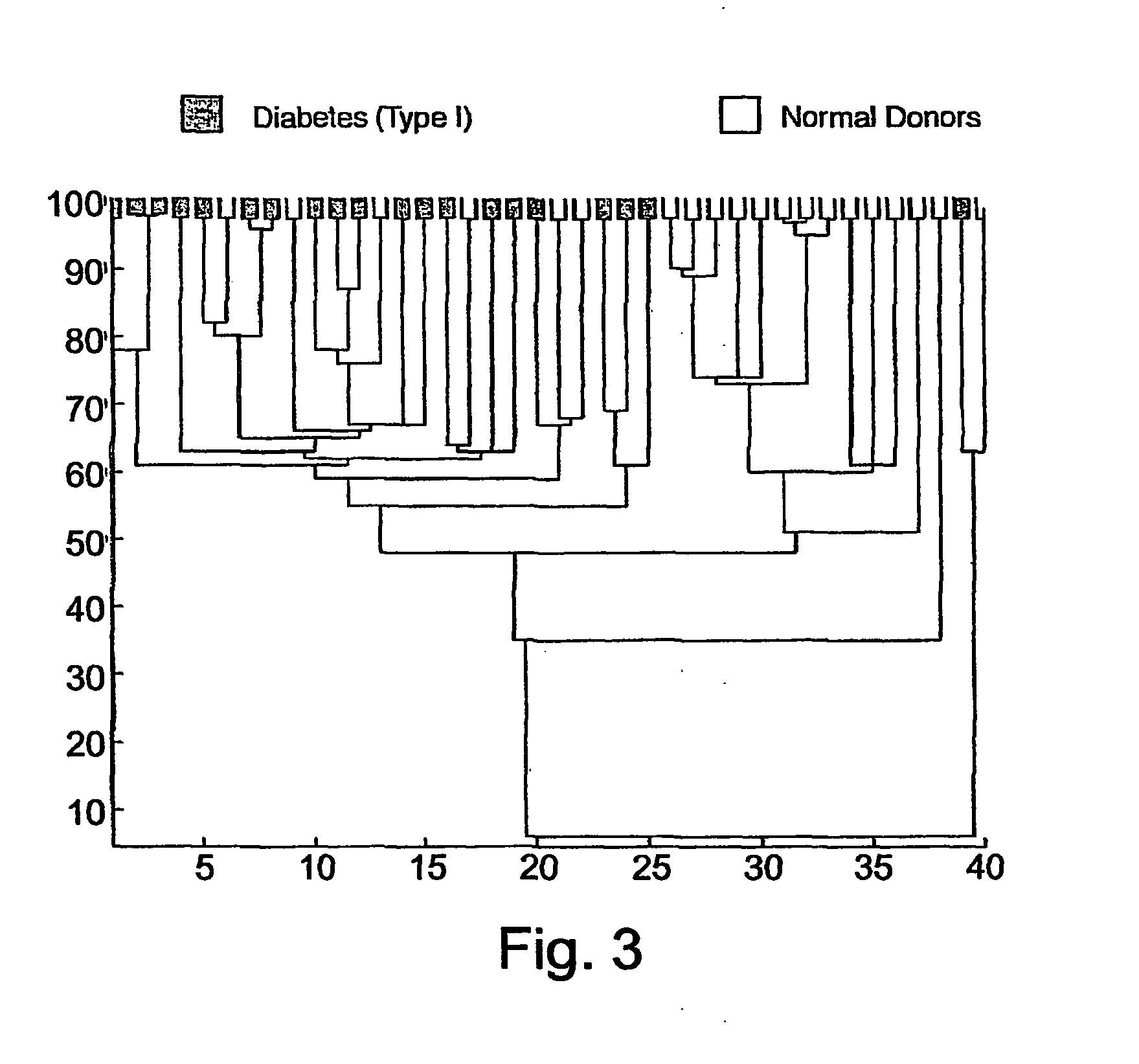Identifying antigen clusters for monitoring a global state of an immune system
- Summary
- Abstract
- Description
- Claims
- Application Information
AI Technical Summary
Benefits of technology
Problems solved by technology
Method used
Image
Examples
example 1
General Methodology
[0091]A general approach to global antibody analysis is described herein aimed to quantitatively assay the binding of patients' antibodies to a large number (tens to hundreds or thousands) of different antigens of human origin (self-antigens) or from other sources, or to libraries of antigens (e.g. expression libraries, peptide libraries, etc), and to analyze, using bio-informatic technology, the global pattern of the reactivities to selected groups of antigens. The bio-informatic process is done in two stages, as follows.
[0092]The first stage includes classification of the antibody patterns characteristic of particular diseases. To this end, sera are collected from healthy persons and from persons known to suffer form certain diseases, and the sera are then assayed for the presence of antibodies binding to the various test antigens. The assays described below were performed using standard ELISA techniques (see below), but the assay system can easily be miniaturiz...
example 2
The Antigens
[0094]The antigens that were used according to the present invention to reveal the global patterns reactivities can be divided into different sets according, for example, to their origin. Different members of each set can be used in the tests. Table 1 below provides a non-limiting example of antigens which can be used in accordance with the teachings of the present invention and which were used to reduce the present invention to practice, as is further detailed hereinunder.
TABLE 1Antigen SetsGroupFunction / OriginAntigenCellular StructureCytoskeletonActinTubulinMyosinTropomyosinVimentinExtracellular matrixFibronectinAcid CollagenCollagen ICollagen IXCollagen VICollagen XHeparinLamininCollagenaseCellularPhospholipidsCardiolipinMembranesGlucocerebrosidePhosphoethanolamineCholesterolCellularGlucoseEnolaseMetabolismAldolaseAlkaline PhosphataseApoptosisAnnexin 33 kDa.Annexin 67 kDa.Cytochrome P450-CMonooxigenasesCatalasePeroxidaseTyrosinaseOthersRibonucleaseNucleusProteinHiston...
example 3
Immunological Methods
[0095]ELISA plates, 96 wells, (Nalge Nunc International) are coated by incubation of the desired antigens dissolved in basic carbonate buffer pH 9.6, for 2 hours at 37° C., followed by an overnight incubation at 4° C. The plates are then washed with PBS Tween0.05% (PBST), and blocked for 2 hours with BSA 3% at 37° C. The sera for analysis are then added at a dilution of 1:100 in BSA 0.3%. After 3 hours of incubation at 37° C., the sera are removed and the plates are washed with PBST. Bound antibodies are detected with an alkaline phosphatase conjugated antibody (Jackson ImmunoResearch Labs. Inc.) that recognizes both human IgG and IgM, incubated for 1.5 hours in a 1:1500 dilution in BSA 0.3% at 37° C. After washing with PBS, the alkaline phosphatase substrate (Sigma) is added at 0.5 mg / ml dissolved in diethanolamine buffer, and the OD at 405 nm is determined after 30 and 60 minutes of incubation at 37° C. Once the readings at 405 nm were done, the plates were wa...
PUM
| Property | Measurement | Unit |
|---|---|---|
| Fraction | aaaaa | aaaaa |
| Atomic weight | aaaaa | aaaaa |
| Atomic weight | aaaaa | aaaaa |
Abstract
Description
Claims
Application Information
 Login to View More
Login to View More - R&D
- Intellectual Property
- Life Sciences
- Materials
- Tech Scout
- Unparalleled Data Quality
- Higher Quality Content
- 60% Fewer Hallucinations
Browse by: Latest US Patents, China's latest patents, Technical Efficacy Thesaurus, Application Domain, Technology Topic, Popular Technical Reports.
© 2025 PatSnap. All rights reserved.Legal|Privacy policy|Modern Slavery Act Transparency Statement|Sitemap|About US| Contact US: help@patsnap.com



